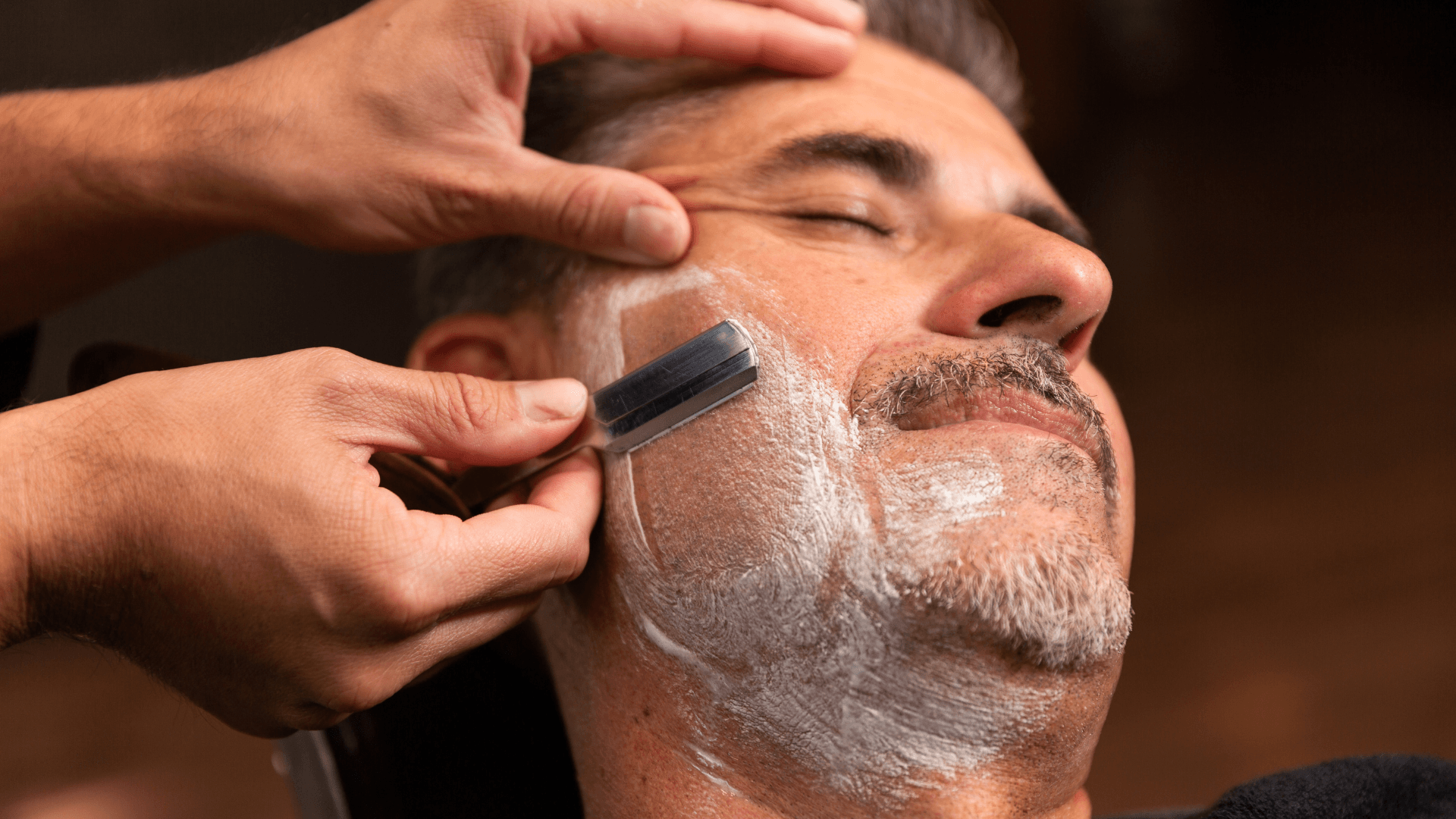A clean, smooth shave can elevate a grooming routine, but razor burns, cuts, and irritation can ruin the experience. The right techniques and products make all the difference. Whether shaving at home or visiting a barber, these 12 hacks help achieve a flawless shave without discomfort.
1. Always Use a Sharp Razor
A sharp razor is one of the most important tools for an irritation-free shave. A dull blade can tug and pull at the hair instead of cutting it cleanly, which can lead to redness, discomfort, and even ingrown hairs. Replacing razor blades regularly—ideally every 5 to 7 shaves—ensures that the blade maintains its sharpness and performs optimally.
Additionally, using a sharp razor reduces the number of passes needed over the same area, minimizing skin irritation and the risk of small cuts. For those with sensitive skin, opting for a quality razor with multiple blades or a safety razor can make a noticeable difference. Proper maintenance is also key; rinsing the blade thoroughly after each use and drying it can prevent buildup and rust, extending its lifespan and ensuring a consistently smooth glide.
2. Warm Towel Prep
One tried-and-true technique used in New York barbershop and around the world—is the warm towel prep. This step involves placing a warm, damp towel over the face for a few minutes before shaving. The heat from the towel softens facial hair and opens up pores, allowing the razor to cut through the hair effortlessly. The result is a smoother shave with less tugging and pulling, which can prevent irritation and razor burn.
The warm towel also helps to relax the skin and increase circulation, creating an indulgent and luxurious experience that feels professional. To try this at home, soak a clean hand towel in hot water, wring it out, and gently press it against your face, covering the shaving area. Alternatively, a dedicated face steamer or even a few extra moments under a hot shower can achieve similar results. Incorporating this technique into your shave routine not only minimizes discomfort but also elevates shaving into a spa-like ritual.
3. Shave After a Warm Shower
Timing is everything when it comes to shaving, and one of the best tricks for a smooth finish is to shave immediately after a warm shower. During a shower, the steam works to soften the beard and hydrate both the facial hair and the skin beneath it. Hair absorbs water and becomes weaker in the presence of heat and moisture, making it easier to cut effortlessly with a sharp razor. This reduces the resistance as the blade moves across the skin, lowering the risk of razor burn, cuts, or bumps.
Shaving post-shower also ensures that your skin is thoroughly cleansed of dirt, oil, and dead skin cells that could clog the razor blade or contribute to irritation. For best results, spend at least five minutes in a warm shower before shaving and use a mild cleanser on your face to prepare the skin. If a shower before shaving isn’t possible, replicating the effect by applying a hot towel to your face can suffice, ensuring your hair and skin are hydrated and ready for an effective shave.
4. Skin Prep with the Right Cleanser
Preparing your skin with the right cleanser is a crucial step for achieving a smooth and comfortable shave. Washing your face with a gentle cleanser helps to remove dirt, excess oil, and impurities that may accumulate on the skin’s surface throughout the day. These contaminants, if left unaddressed, can clog the razor blade and hinder its effectiveness, leading to an uneven shave or even irritation. Furthermore, a proper cleansing routine ensures that dead skin cells are removed, allowing the razor to glide effortlessly across the skin rather than catching on debris.
When choosing a cleanser, opt for one that is free of harsh chemicals or exfoliating beads that could irritate freshly shaved skin. Look for ingredients like glycerin or aloe vera, which provide hydration, and avoid products with strong fragrances that might cause sensitivity. Cleansers specifically formulated for your skin type—be it oily, dry, sensitive, or combination—are ideal for maintaining balance and preventing irritation.
It’s also important to cleanse with warm water, as this helps to open your pores and soften the hair follicles, making them easier to cut. A circular motion with your fingertips will gently massage the cleanser into your skin, thoroughly removing buildup without causing strain. Once rinsed, pat your face dry with a clean towel, leaving the skin slightly damp to retain moisture before moving on to your shaving routine. Proper skin preparation not only enhances the effectiveness of your shave but also reduces the risk of nicks, cuts, and post-shave breakouts, leaving you with softer, healthier-looking skin.
5. Use a Quality Shaving Brush
Investing in a high-quality shaving brush can be a game-changer for your grooming routine. A shaving brush is not only a traditional tool but also a highly effective one. Its purpose goes beyond merely applying shaving cream; it actively works to lift and separate the hairs on your face, positioning them for a cleaner and closer cut. This action minimizes the number of passes required with your razor, thus reducing irritation and the likelihood of ingrown hairs.
A good shaving brush also ensures even distribution of shaving cream or soap across your face. Unlike applying cream with your hands, which can sometimes be uneven and leave patches of skin unprotected, a brush creates a thick, rich lather that cushions the skin and provides a slick surface for your razor. This protective barrier is crucial for reducing friction and preventing cuts, especially if you have sensitive or easily irritated skin.
When selecting a shaving brush, consider the bristle type. Brushes made from natural fibers, such as badger or boar hair, are highly absorbent and ideal for creating a luxurious lather. Synthetic brushes, on the other hand, are hypoallergenic and dry more quickly, making them an excellent choice for those who prefer an easy-to-maintain alternative. Whichever type you choose, using a circular motion with the brush as you apply the cream helps to exfoliate your skin gently, removing additional dead skin cells and allowing for a smoother shave.
To make the most of your shaving brush, keep it clean and dry between uses. Rinse it thoroughly to remove any residue, gently squeeze out excess water, and store it bristle-side down to prevent water from collecting at the base. Proper care will extend the life of your brush and keep it in optimal condition for your grooming needs.
By incorporating a quality shaving brush into your regimen, you’ll improve not only the effectiveness of your shave but also the overall experience, leaving your skin feeling refreshed, smooth, and revitalized.
6. Shaving Creams Matter
Not all shaving creams are created equal, and selecting the right product can make a significant difference in the quality of your shave. Opt for shaving creams that are specifically formulated with moisturizing and skin-friendly ingredients such as aloe vera, glycerin, or coconut oil. These ingredients not only protect your skin from dryness but also ensure adequate hydration during the shave. Hydration is critical because it softens the hair and allows for smoother razor glides, reducing the risk of cuts, nicks, and irritation.
Additionally, high-quality shaving creams provide superior lubrication, creating a protective barrier between your skin and the razor blade, thereby minimizing friction. Avoid products that contain harsh chemicals, alcohol, or artificial fragrances, as these can lead to dryness, inflammation, or allergic reactions, particularly for individuals with sensitive skin. Remember, the right shaving cream not only safeguards your skin but also elevates the shaving experience, making it a comfortable and luxurious routine.
7. Shave with the Grain First
Shaving in the direction of hair growth—commonly referred to as “with the grain”—is a pivotal step in achieving a comfortable and irritation-free shave. Going against the grain too soon often leads to razor burn, bumps, and ingrown hairs, especially for those with sensitive skin or curly facial hair. Start your shave by carefully analyzing the direction in which your hair grows—this can vary depending on the area of the face or neck. Once identified, glide the razor gently with the grain, using short, deliberate strokes and minimal pressure.
This initial pass will remove a significant portion of the hair while protecting your skin. If you’re looking for an even closer shave, allow your skin to recover with moisturizing lather from your shaving cream and make a second pass across the grain or, if your skin tolerates it, against the grain. Take care to stretch the skin lightly for a smooth surface and avoid going over the same spot repeatedly as this can lead to irritation. Achieving the optimal combination of comfort and closeness requires patience and attention to your skin’s needs.
8. Cold Water Rinse
One often-overlooked final touch to a professional-grade shave is finishing with a cold water rinse. After completing your shave, splash cold water generously over your face and neck. The cold water helps close your pores, which minimizes exposure to dirt and bacteria that can cause breakouts or irritation. This step is particularly emphasized by barbers in New York, where the fast-paced lifestyle demands effective grooming techniques that maximize both results and efficiency.
The cooling effect also soothes any post-shave redness or inflammation, leaving the skin feeling refreshed and invigorated. For an added layer of care, pat your skin dry with a clean towel (avoid rubbing as this can cause irritation) and apply an alcohol-free aftershave balm to lock in moisture and further calm your skin. Many New York barber professionals swear by this routine not only to improve the appearance and feel of the skin but also to prevent common shaving issues like ingrown hairs. Incorporating this habit into your daily regimen can transform your shave from a simple task into a refined self-care ritual.
9. Apply a Soothing Aftershave
After completing your shave, applying a soothing aftershave is an essential step to protect and nourish the skin. Many traditional aftershaves contain alcohol, which can leave the skin feeling dry and irritated, especially for individuals with sensitive or easily reactive skin. Instead, opt for an alcohol-free aftershave balm or lotion that is specifically designed to calm and hydrate the skin. Look for products enriched with natural ingredients like witch hazel, chamomile, aloe vera, or calendula. These ingredients are known for their anti-inflammatory and soothing properties, helping to reduce redness and irritation caused by shaving.
Additionally, a good aftershave balm can help close pores, creating a protective barrier that locks in moisture and shields the skin from external pollutants. It also promotes faster healing of any minor nicks or abrasions, leaving your face feeling smooth and refreshed. To apply, pour a small amount of balm, about the size of a dime, onto your palm and gently massage it into your skin using light, upward motions. This ensures even distribution and maximizes absorption. By incorporating a high-quality, calming aftershave into your routine, you elevate your shaving experience into a comprehensive skincare practice that keeps your skin healthy, hydrated, and irritation-free.
10. Avoid Touching the Face Post-Shave
Freshly shaved skin is particularly delicate and vulnerable to environmental factors. After shaving, the outermost layer of your skin has been slightly exfoliated, making it more sensitive and prone to irritation. During this time, it is important to avoid touching your face unnecessarily, especially with unwashed hands. Our hands carry a significant amount of bacteria, dirt, and oil accumulated throughout the day. When transferred to freshly shaved skin, these elements can clog pores and lead to unwanted breakouts, irritation, or even infections.
Resist the urge to touch or scratch your face after shaving, even if the skin feels slightly itchy or tight. Instead, focus on maintaining a clean and refreshed appearance by keeping your hands away and limiting contact with potentially irritating substances like dirty towels or pillows. If you need to handle your face, such as when applying moisturizer or sunscreen, make sure to wash your hands thoroughly with soap and warm water beforehand. This simple precaution reduces the risk of introducing harmful bacteria, ensuring your skin remains smooth, clear, and healthy after every shave.
11. Replace Razors Regularly
One of the most overlooked aspects of a proper shaving routine is the condition of your razor. Using a dull or worn-out razor can dramatically increase the likelihood of skin irritation, razor burn, and even small cuts. Over time, razor blades lose their sharpness and collect buildup, including dead skin cells, shaving cream residue, and bacteria. This not only compromises the effectiveness of the shave but also exposes your skin to potential infections.
To maintain the best possible results, it is essential to replace your razor blades or disposable razors regularly. For most individuals, this means switching to a fresh blade after 5 to 10 shaves, depending on the thickness of your hair and the quality of the razor. If you notice signs such as tugging, pulling, or increased irritation while shaving, it is a clear indicator that your blade needs replacing.
Investing in high-quality blades and proper care for your razor can also extend its usability. After each shave, rinse your razor thoroughly under warm water to remove any debris and pat it dry to prevent rust. Store your razor in a dry, clean environment, avoiding damp areas where bacteria can thrive. By prioritizing the regular replacement and care of your blades, you ensure a safer, smoother shave every time, while minimizing the risk of skin issues. With fresh, sharp razors, you can maintain a clean and polished look with ease and comfort.
12. Moisturize Daily
Keeping your skin hydrated is an essential step to maintain its health and appearance between shaves. Regular moisturizing prevents dryness, flakiness, and irritation, ensuring your skin remains soft and smooth. Opt for a lightweight, non-comedogenic moisturizer, as it hydrates the skin without clogging pores, making it suitable for all skin types, including sensitive or acne-prone skin. For best results, apply the moisturizer after shaving or washing your face when the skin is slightly damp, as this helps lock in moisture effectively. Ingredients such as hyaluronic acid, glycerin, and ceramides are excellent choices to restore and maintain a healthy skin barrier, providing long-lasting hydration throughout the day.
Conclusion
Achieving a smooth, irritation-free shave is entirely possible with the right techniques and products. From prioritizing proper Skin Prep to selecting the most suitable Shaving Creams, these 12 shaving hacks ensure an effortless and comfortable experience every time. By adopting these practices, you can minimize common shaving concerns like razor burn, ingrown hairs, and dryness. Whether you implement these steps in your daily routine at home or enlist the expertise of a professional at a trusted New York Barbershop, these tips will help you maintain healthy, polished, and smooth skin. Make shaving a part of a comprehensive skincare routine, and enjoy the benefits of a confident, well-groomed appearance.


